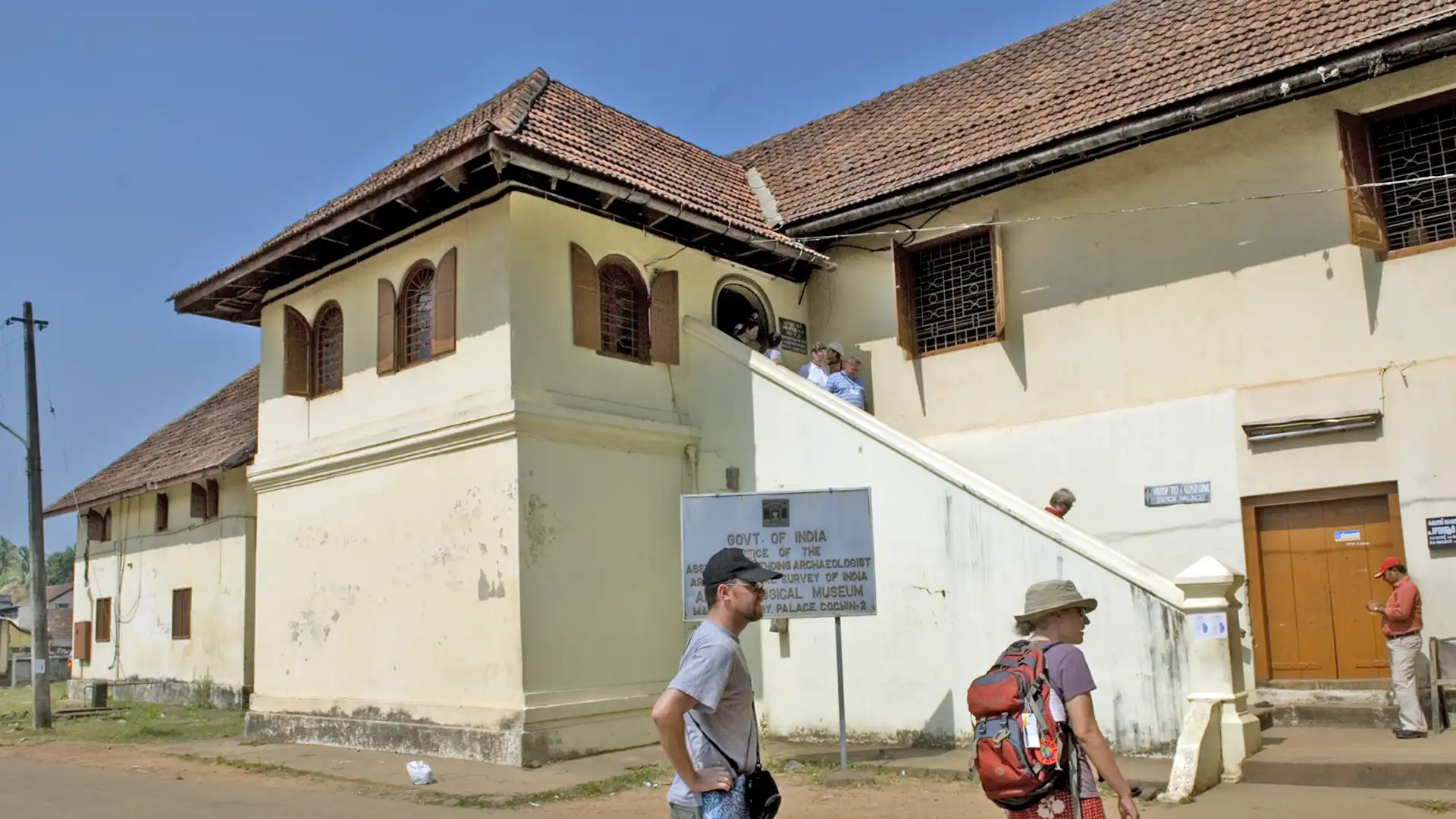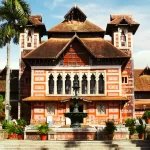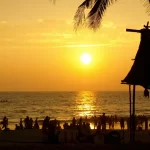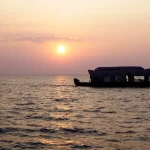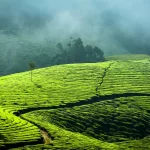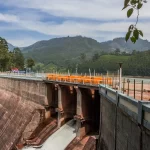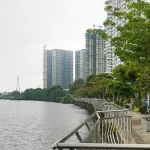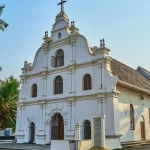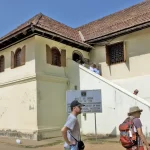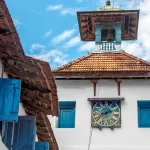Here are some key points about Mattancherry Palace Kochi:
- Built by the Portuguese in 1555 and gifted to the King of Cochin as a token of alliance.
- Renovated by the Dutch in 1663, hence popularly called the Dutch Palace.
- A fine example of Kerala’s nalukettu-style architecture combined with European elements.
- The palace has a quadrangular structure with a central courtyard and temples.
- Dedicated shrines include Pazhayannur Bhagavathy (goddess of the royal family), Lord Krishna, and Lord Shiva.
- Known for its elaborate murals that cover entire walls, portraying episodes from the Ramayana, Mahabharata, and Bhagavata Purana.
- Some murals also depict themes from Krishna Leela and Shiva Parvati stories.
- The murals are painted in natural vegetable dyes, showcasing Kerala’s traditional mural art.
- The upper floor contains royal chambers, audience halls, and exhibits of the Cochin rulers.
- Displays include portraits of the Cochin Rajas, royal costumes, palanquins, ceremonial swords, and coins.
- The coronation hall features intricately decorated wooden ceilings with brass embellishments.
- The palace provides insights into the political ties between Kerala’s rulers and colonial powers.
- Offers a glimpse of the evolution of Cochin’s culture, trade, and traditions.
- Listed as a protected monument under the Archaeological Survey of India (ASI).
- A must-visit for those interested in history, art, architecture, and Kerala’s royal heritage.
- Located in Mattancherry, a heritage hub close to the Paradesi Synagogue, spice markets, and antique shops.
- Photography inside the palace is restricted, preserving the delicate murals.
- Open to visitors on most days, with a nominal entry fee.
- Best time to visit is during October to March, when the weather is comfortable for sightseeing.
Mattancherry Palace, also known as the Dutch Palace, is a stunning historical monument located in the heart of Kochi, Kerala. This magnificent palace is a treasure trove of Kerala’s rich cultural and royal heritage. Let’s delve into its fascinating history, architectural beauty, and cultural significance.
A Brief History of Mattancherry Palace
The Portuguese built Mattancherry Palace in 1555 and gave it to the Raja of Kochi as a peace offering. They had accidentally damaged a temple, so this was their way to make things right. The Raja accepted the gift, allowing the Portuguese to trade in Kochi.
Later, the Dutch took over Kochi and made some changes to the palace. Even though they changed it a bit, the palace still has its original Kerala style with some European touches.
For a long time, Mattancherry Palace was the home of the Kochi royal family and a place for special events. Now, it’s a museum where people can learn about the royal family’s lives and Kochi’s history.
Architectural Features of Mattancherry Palace
Mattancherry Palace is a good example of Kerala’s traditional style of building, called “Nalukettu.” Nalukettu buildings have sloping roofs, wooden ceilings, and big courtyards. Let’s look at some of the palace’s special features:
The Entrance and Courtyard
The palace is like a typical Kerala house, with a big open space in the middle and rooms around it. Simple yet elegant, the entrance leads to a spacious courtyard that once hosted special events. There’s also a small temple in the courtyard dedicated to the royal deity, Pazhayannur Bhagavathy.
Murals and Wall Paintings
One of the attractive things about Mattancherry Palace are the beautiful murals and paintings on the walls. The murals, painted in a traditional Kerala style, depict stories from the Ramayana and Mahabharata, using natural colors made from vegetable and mineral dyes.
The murals are in different rooms throughout the palace, and each room tells a different story. One of the most famous murals depicts the kingship of Rama, the hero of the Ramayana. It’s considered a masterpiece of Kerala mural art.
The King’s Bedchamber (Palliyara)
The King’s Bedchamber is a special room in the palace. Beautiful murals about Lord Krishna cover the walls. The room is small but very fancy, which shows how important it was to the royal family.
The Coronation Hall (Kulathupuzha)
The Coronation Hall is where the Rajas of Kochi were crowned kings. It’s a big room with wooden ceilings and lots of windows. The walls have murals of gods, goddesses, and scenes from the royal family’s life.
The Dining Hall
The dining hall is another special room in the palace. It has a big, long wooden table where the royal family and their guests would eat. The walls have murals, but they’re not as bright as the ones in the other rooms.
Wooden Ceilings and Carvings
The palace features beautifully crafted wooden ceilings and detailed carvings on the walls and doors. These wooden designs are a common feature of traditional Kerala architecture and add to the palace’s charm and elegance.
The Cultural Significance of Mattancherry Palace
Mattancherry Palace is more than just a beautiful building. It shows how rich Kerala’s culture and history are. The palace’s murals tell us about the religious and cultural life of the people of Kerala. The building itself shows how different cultures have come together in the region over the years.
For the people of Kochi, Mattancherry Palace is a reminder of their royal past. The palace has seen many important events in the history of the Kochi royal family.
Today, the palace is a museum that people from all over the world visit. The museum has things that belonged to the royal family, pictures of the Rajas of Kochi, and old documents that tell us more about Kochi’s history and its rulers.
Visiting Mattancherry Palace
Mattancherry Palace is located in the heart of Mattancherry, a bustling area in Kochi known for its historical sites and vibrant markets. Here are some tips for visiting the palace:
- The palace is open to visitors from 9:00 AM to 5:00 PM, except on major festivals.
- There is a small entrance fee to visit the palace.
- The best time to visit Mattancherry Palace is during the morning or late afternoon, when the crowds are smaller.
- Photography is allowed inside the palace, but flash photography is prohibited.
- After visiting Mattancherry Palace, you can explore other nearby attractions such as the Jew Town Synagogue, the Indo-Portuguese Museum, and the Mattancherry Market.
Conclusion
Mattancherry Palace is a wonderful place to visit if you like Kerala’s history and culture. The palace shows you how the Kochi rulers lived and the beautiful art that Kerala has.
If you like art, history, or just exploring, Mattancherry Palace is a must-see. Its beautiful murals, lovely architecture, and important history make it one of Kerala’s most special places.
So, if you’re ever in Kochi, don’t miss Mattancherry Palace. You’ll learn about the royal heritage of “God’s Own Country.”

